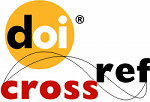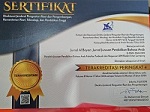Collaborative-Based Tashrif Lughowy in Qiroatul Kutub Learning Using the Reverso
Abstract
Keywords
Full Text:
PDFReferences
Abd-Elmoneim, Dina Mohammed, Hassan Hosney Ghandour, Dina Ahmed Elrefaie, and Mona Sameeh Khodeir. “Development of an Arabic Test for Assessment of Semantics for the Arabic-Speaking Children: The Arabic Semantic Test.” The Egyptian Journal of Otolaryngology 39 no. 1 (March 14, 2023): 1-16.
Abed, Baneen Aqeel, and Mushin Mohammad Majwai AI-Jubori. “The Effect of the Performance-Based Assessment Strategy on the Achievement of Second-Grade Students the Averages Subject in Arabic Grammar.” PalArch’s Journal of Archaeology of Egypt/Egyptology 17, no. 6 (2020): 2501–2510.
Akhyaruddin, Akhyaruddin. “Implementasi Project Based Learning-Case Method (PjBL-CM) dalam Pembelajaran Morfologi Bahasa Indonesia.” Jurnal Ilmiah Dikdaya 12, no. 1 (2022): 1–6.
AL Harrasi, Kothar Talib Sulaiman. “Reexamining Feedback in the Context of Different Rhetorical Patterns of Writing.” Language Testing in Asia 13, no. 1 (2023): 4.
Alduailej, Alhanouf, and Abdulrahman Alothaim. “AraXLNet: Pre-Trained Language Model for Sentiment Analysis of Arabic.” Journal of Big Data 9, no. 1 (2022): 1-21.
Alfalah, Adib, Asep Sopian, Nunung Nursyamsiah, and Ashabul Kahfi Susanto. “Arabic Dairy Caption Project: Reactualisation of Project-Based Learning for Instagram-Based Arabic Writing Skills.” Lisanul Arab: Journal of Arabic Learning and Teaching 12, no. 1 (2023): 23–35.
Al-Maleh, Molham, and Said Desouki. “Correction to: Arabic Text Summarization Using Deep Learning Approach.” Journal of Big Data 8, no. 1 (2021): 56.
Ardiansyah, Ade Arip, and Azhar Muhammad. “Implementation of Integrative Arabic Grammar (Nahwu & Sharaf) Curriculum in Islamic Boarding School.” Izdihar: Journal of Arabic Language Teaching, Linguistics, and Literature 3, no. 3 (2020): 211–228.
Febriani, Erma, and Cahya Adi Prabowo. “Developing Interactive Multimedia Based Learning Media for Foreign Students.” Atlantis Press (2021).
Hakim, Angela. “Genre-Related Episodes as A Lens On Students’ Emerging Genre Knowledge: Implications for Genre-Based Writing Pedagogy, Collaborative Tasks, and Learning Materials.” Journal of Second Language Writing 60 (2023): 101001.
Hilal, Tariq Abu, Ala’ Abu Hilal, and Hasan Abu Hilal. “Social Networking Applications: A Comparative Analysis for a Collaborative Learning through Google Classroom and Zoom.” Procedia Computer Science 210 (2022): 61–69.
Islamiyah, Amalia H., and Muassomah. “Strategi Group Investigation dalam Pembelajaran Mahārat al-Qirā’ah pada Mahasiswa Jurusan Bahasa dan Sastra Arab, UIN Maulana Malik Ibrahim, Malang.” Al-Ma‘rifah 17, no. 1 (2020): 1–11.
Khoiriyah, Hidayatul. “Metode Qira’ah dalam Pembelajaran Keterampilan Reseptif Berbahasa Arab untuk Pendidikan Tingkat Menengah.” لسـانـنـا (Lisanuna): Jurnal Ilmu Bahasa Arab dan Pembelajarannya 10, no. 1 (2020): 32–44.
Khudair, Wisal Moayad, Rasim Ahmed Abees, and Hassanein Ali Diwan. “Evaluating the Performance of Arabic Language Teachers In Light of Skillful Thinking Skills.” PalArch’s Journal of Archaeology of Egypt/Egyptology 17, no. 6 (2020): 2511–2533.
Lieber, Rochelle. Introducing Morphology. Cambridge Introductions to Language and Linguistics. Cambridge: Cambridge University Press, 2009.
Loi, Alexsander. “Applying the Problem-Based Learning Model in Improving Reading Skill at Eight Grade of SMP PGRI 3 Denpasar.” International Linguistics and TESOL Journal 1, no. 2 (2023): 22–26.
Maisa, Mwafaq Seh. “Educational Values Included in Arabic Language Curricula for Primary School Students in Galilee’s Arab Society.” Journal of Positive School Psychology (2022): 4482–4495.
Mamun, Titin Nurhayati, and Tanty Riyani. “Codification of Arabic Verb Inflection: Easy Method to Understand the Basic of Words’ Formation for Indonesian Learners.” In Proceeding of 2nd International Conference on Islamic Education (2018).
Mannaa, Zarah M., Aqil M. Azmi, and Hatim A. Aboalsamh. “Computer-Assisted i‘raab of Arabic Sentences for Teaching Grammar to Students.” Journal of King Saud University - Computer and Information Sciences 34, no. 10 (2022): 8909–8926.
Muid, Abdul, Muhammad Fadhlan, Rasidin Rasidin, and Muhammad Dasrul Jabir. “Project-Based Learning Models Approach in Improving Arabic Speaking Ability.” An Nabighoh 24, no. 1 (2022): 17–32.
Rabie-Ahmed, Amr, and Ayman Mohamed. “Collaborative and Individual Vocabulary Learning In the Arabic Classroom: The Role of Engagement and Task Demands.” Foreign Language Annals 55, no. 4 (2022): 1006–1024.
Ramli, Saipolbarin Ramli et. “Collaborative Learning to Enhance Arabic Speech Skills Among Students of Bachelor’s Degree (ISM) In Arabic Language With Education at Sultan Idris Education University.” Psychology and Education Journal (2020).
Srifi, Mehdi, Ahmed Oussous, Ayoub Ait Lahcen, and Salma Mouline. “Evaluation of Recent Advances in Recommender Systems on Arabic Content.” Journal of Big Data 8, no. 1 (2021): 1-19.
Ritonga, Apri Wardana, Ayu Desrani, and Yohan Rubiyantoro. “Arabic Learning Design Based on 21st Century Skills during the Covid-19 Pandemic in Indonesia.” Jurnal Iqra’: Kajian Ilmu Pendidikan 7, no. 2 (2022): 1–14.
Xu, Wenqin, Chen Chen, Shuxin Ding, and Panos M. Pardalos. “A Bi-Objective Dynamic Collaborative Task Assignment under Uncertainty Using Modified MOEA/D with Heuristic Initialization.” Expert Systems with Applications 140 (2020): 112844.
Yurisa, Penny Respati. “Maharah Al-Qiraati wa Ta’limuha wa Muasyiratuha.” International Journal of Arabic Language Teaching 1, no. 01 (2019): 42.
Zubaidi, Ahmad, Siti Afifah Adawiyah, Dailatus Syamsiyah, and Yuyun Zunairoh. “Contextual-Based Qiroatul Kutub Learning Using the Plickers.” Jurnal Al Bayan: Jurnal Jurusan Pendidikan Bahasa Arab 14, no. 1 (2022): 156–175.
DOI: http://dx.doi.org/10.24042/albayan.v15i2.19440
Refbacks
- There are currently no refbacks.
Copyright (c) 2023 Jurnal Al Bayan: Jurnal Jurusan Pendidikan Bahasa Arab
License URL: https://creativecommons.org/licenses/by-nc-sa/4.0
Editorial Office:
Jurnal Al Bayan: Jurnal Jurusan Pendidikan Bahasa Arab, Arabic Education Study Program, Faculty of Education and Teachers Training, Unversitas Islam Negeri Raden Intan Lampung
Jl. Endro Suratmin 1 Sukarame, Bandar Lampung 35131-Indonesia
e-mail: jurnalalbayan@radenintan.ac.id
http://ejournal.radenintan.ac.id/index.php/albayan/index
Jurnal Al Bayan: Jurnal Jurusan Pendidikan Bahasa Arab is licensed under a Creative Commons Attribution-ShareAlike 4.0 International License. p-ISSN 2086-9282 | e-ISSN 2549-1229









